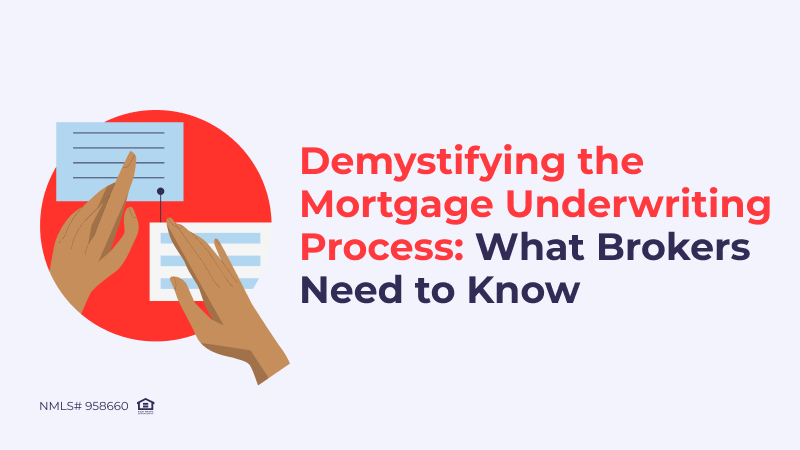
You’re probably familiar with the term “mortgage underwriting.” But what it really means? Essentially, mortgage underwriting is the process where a mortgage lender analyzes a borrower’s financial health to determine if a mortgage will fit their long-term goals. This is a key step in the loan approval process, as it helps a lender determine whether or not to approve a loan. However, it’s not a simple yes or no – it’s a deep dive into the details.
It involves a lot of complexity and nuances, and there are several factors that underwriters consider when evaluating a borrower’s application. All of these factors can have a significant impact on the outcome of a mortgage application process. That’s why it’s so important for mortgage brokers to have a clear understanding of mortgage underwriting. The more you understand the underwriting process, the more successful the outcome for everyone involved, and, eventually, the better you can serve your clients. With this knowledge, you’ll be able to explain upfront what factors influence approval and advise them on how to strengthen their financial profile for a smooth process.
Let’s take a closer look at underwriting, what it entails, and its potential challenges so you can better prepare your clients for successful loan approvals.
Overview of Mortgage Underwriting
So, what exactly is underwriting in mortgage, and how does it impact the homebuying process? At its core, it’s the in-depth financial examination of a borrower, determining whether they are eligible for a home loan. The underwriting process takes place after a borrower has submitted a complete loan application and their offer on a house has been accepted. It happens behind the scenes while the seller gathers documents for closing and other steps move forward. This in-depth analysis typically takes anywhere from a few days to several weeks to complete, depending on the complexity of the file and the lender’s workload.
Looking for a suitable loan program?
Choose among 20+ programs and get
a detailed loan calculation
As mentioned above, during underwriting, a lender needs to carefully evaluate several factors. They look at a borrower’s credit score to determine the applicant’s creditworthiness, as well as their debt-to-income ratio, to assess their ability to make payments. They also review employment history, income stability, and other factors to ensure that a borrower is financially stable enough to take on a mortgage. All of these factors paint a clearer picture of their current financial situation and their ability to handle the added responsibility of a mortgage payment.
Additionally, for risk management purposes, lenders consider the type of loan the borrower is applying for, the property they’re purchasing, and the current state of the housing market. They want to ensure that they’re making a loan that the borrower can repay and that the property itself will serve as adequate collateral in case of default.
In the home buying process, underwriting acts as a gatekeeper, defining not only the applicant’s eligibility but also the specific loan terms they qualify for. That is, by evaluating a borrower’s financial situation and the property itself, underwriters determine the risk involved in approving the loan. This helps them set the amount of money a lender is willing to lend, the interest rate, and the down payment requirements that protect the lender’s investment. This also ensures that a borrower gets a mortgage with terms they can manage comfortably. Ultimately, a successful underwriting process paves the way for a smooth closing.
It’s important to keep in mind that underwriting standards can vary from lender to lender. Some lenders may be more willing to take on riskier borrowers, while others may be more conservative. You are the one who can help your clients find the lender that best fits their financial situation.
Key Players in Mortgage Underwriting

Troubles with a scenario for a borrower?
Message our loan expert and get
a response in 30 minutes.
It may seem that only underwriters are responsible for the underwriting process. But behind the scenes, an entire team works together to make it happen. It includes underwriters, loan officers, appraisers, and mortgage brokers.
- Underwriters are responsible for evaluating the financial information provided by the borrower to determine if they are a good candidate for a mortgage. Underwriters are employed by the lender and work to ensure that the lender’s risk is minimized when granting a mortgage to the borrower.
- Loan officers work with borrowers to help them through the mortgage process to find the right product for their needs. They work with underwriters to ensure that all necessary documentation is submitted and that the loan is approved promptly.
- Appraisers are independent professionals who assess the value of the property your client is purchasing. This is important because the lender needs to ensure that the property is worth the amount of the loan being requested.
- The mortgage broker’s role is to facilitate the interactions between these players and ensure that everything runs smoothly. They work with the borrower to understand their needs and goals and then help them find the right mortgage product. Once the borrower has selected a mortgage, a broker works with the loan officer to ensure that all necessary documentation is submitted to the underwriter. They also work with the appraiser to schedule the property evaluation and ensure that it is completed in a timely manner. This results in a faster turnaround time and a less stressful experience for applicants.
Steps in the Mortgage Underwriting Process
Underwriting is like a complex security check with multiple steps. Let’s break down the mortgage underwriting steps.
Application review
The first step in the mortgage underwriting process is to review the borrower’s mortgage application. The underwriter reviews the applicant’s income, employment history, credit score, and debt-to-income ratio. They also look at the borrower’s assets, including savings, retirement accounts, and investment accounts. The underwriter must ensure that the mortgage application is complete and accurate.
Credit analysis
The next step is the credit analysis. Credit score – it’s a number that carries significant weight in the mortgage underwriting process. A good credit score is essential for loan approval. But underwriters don’t stop there. They have to review the borrower’s credit report to understand the story behind the score. Any blemishes or delinquencies are carefully examined, along with the applicant’s explanation and recent credit behavior. The underwriter reviews the borrower’s credit history, including their payment history, the length of their credit history, and the types of credit they have. This analysis helps assess their creditworthiness and ability to manage future loan payments responsibly.
Property appraisal
Another step in the mortgage underwriting process is the property appraisal.
An independent appraiser visits the property to determine its fair market value. This appraised value becomes a key factor in the lender’s risk assessment – the house itself serves as collateral for the loan. A property valued lower than the loan amount could raise red flags.
The underwriter reviews the property’s value to ensure that it’s worth the loan amount. They also look at the property’s location, size, condition, and comparable sales in the area. Additionally, the underwriter has to ensure that the property meets the underwriting criteria, such as no structural damage, no zoning violations, and no environmental hazards.
Risk assessment and decision
The final step in the mortgage underwriting process is risk assessment and decision. The underwriter assesses the borrower’s risk of default and makes a decision on whether to approve or deny the loan. They analyze the whole picture, applying the underwriting criteria established by the lender. This risk assessment considers not only the applicant’s financial situation but also the specific loan type and the current state of the housing market.
Based on this analysis, underwriters make the final loan approval decision. They may approve the loan as requested, approve the loan with certain conditions (such as a higher down payment), or deny the loan application if the risk appears too high. If the underwriter approves the loan, they will provide conditions for the loan. If the underwriter denies the loan, they will provide a reason for the denial.
Common Challenges in Mortgage Underwriting and How to Overcome Them

Looking for a suitable loan program?
Choose among 20+ programs and get
a detailed loan calculation
Even the most thoroughly prepared mortgage application can hit a snag during the underwriting process, causing frustration for both brokers and their clients. Here’s a breakdown of some common roadblocks you may encounter and the strategies you can use to overcome them:
Documentation gaps
One of the most common challenges during the underwriting process is documentation gaps. This means that the borrower hasn’t provided all of the required documentation. The complete documentation package is necessary for the underwriter to accurately assess the applicant’s financial situation. Income gaps due to recent job changes, misplaced tax returns, or unexplained deposits on bank statements can raise red flags for underwriters. As a result, it can slow down the underwriting process or even lead to a loan denial.
What can brokers do to help their clients with documentation gaps? The key is to be proactive, detail-oriented, and well-organized. Brokers should work with their clients to create a checklist of all required documentation and ensure that they have everything before applying. Set a deadline for submitting documentation and follow up frequently to ensure that everything is in order. If there are gaps in employment or missing documents, work with your client to get written explanations. Did they take time off to care for children? Did they freelance for a period of time? Having clear justifications can address the underwriter’s concerns and prevent delays.
Appraisal problems
Another thing that can cause issues is appraisal. As mentioned above, the lender requires an appraisal to determine the value of the property. If the appraisal comes in lower than expected, it can affect the loan amount and even lead to a loan denial.
How to help your clients with appraisal problems? First, it’s necessary to set realistic expectations with clients from the very beginning. Explain that the appraisal is an independent evaluation, and the lender has no control over the outcome. You can also help by providing the appraiser with any relevant information about the property that may impact its value. This could be recent upgrades or renovations, the property’s unique features, or any other relevant details. If the appraisal comes in lower, you can work with your client to renegotiate the offer price with the seller. This might involve a lower purchase price or the seller covering the appraisal gap.
Credit issues
Credit issues are another common challenge in mortgage underwriting. If the borrower has a low credit score, it can lead to a loan denial or higher interest rates. What can you do in this case? Be forward-thinking and encourage your clients to check their credit reports before applying for a loan. If there are any errors or inaccuracies, they should be addressed before applying. You can also work with clients to improve their credit scores, such as paying off debts or disputing inaccuracies.
By addressing these challenges and taking proactive steps, you can greatly improve your client’s chances of a smooth underwriting process.
How Brokers Can Prepare Clients for Underwriting
Underwriting is a critical step in the loan approval process, and it’s important to be well-prepared to get through it successfully. And it’s your job as a mortgage broker to help your clients prepare. Here’s how you can do that:
- Organize financial documents. Underwriting is like a financial audit. The more organized your clients are, the better. Advise them to gather all documents well in advance – pay stubs, tax returns, bank statements – anything that paints a clear picture of their financial health. Encourage them to ensure that these documents are up-to-date, accurate, and complete. A well-organized file demonstrates responsibility and streamlines the process for everyone.
- Improve credit scores. A strong credit score is a golden ticket in the underwriting world. Encourage your clients to check their credit reports beforehand and suggest ways to improve their scores if they are low. Even small improvements in credit scores can make a big difference in their loan approval chances and help them get better loan terms, such as lower interest rates.
- Emphasize accuracy and honesty. It’s essential to emphasize to your clients the importance of accuracy, completeness, transparency, and honesty when submitting their loan applications. One mistake or omission can have a significant impact on their application and potentially delay or even deny their approval. So, this is not a time to exaggerate or hide any details. Encourage your clients to be upfront and honest about their financial situation. Have them disclose any income gaps, outstanding debts, or credit blemishes and provide all necessary information. Having clear explanations for any potential red flags can prevent delays and denials.
If you walk your clients through these steps, you will set them up for success. Remember, a prepared and informed client is a confident client, and that translates to a smoother underwriting process for everyone involved.
Client Preparation Checklist for Mortgage Underwriting
Organize Financial Documents
- Advise clients to gather all documents well in advance.
Documents to collect:
Pay stubs (past 30-60 days)
Tax returns (past 2 years)
Bank statements
Investment statements (if applicable)
Proof of other income sources (if applicable)
- Ensure documents are up-to-date, accurate, and complete.
Improve Credit Scores
- Encourage clients to check their credit reports beforehand.
- Suggest strategies to improve credit scores, if necessary.
Paying off debts / disputing inaccuracies
Emphasize Accuracy and Honesty
- Explain the importance of accuracy, completeness, and transparency in the application.
- Highlight the consequences of mistakes or omissions (delays, denials).
- Encourage clients to be upfront and honest about their financial situation.
Disclose any:
Income gaps
Outstanding debts
Credit blemishes
- Prepare explanations for any potential red flags to prevent delays.
The Future of Mortgage Underwriting
Technological progress surrounds us everywhere, affecting almost all areas of our lives, and the mortgage industry is no exception. One of the new trends here is the use of automated underwriting systems. These systems use algorithms and artificial intelligence to process and analyze large amounts of data and determine mortgage eligibility in seconds. This makes the process faster, more efficient, and more user-friendly.
Another technology trend is digital mortgage applications. These online applications allow borrowers to submit information and documents electronically, saving time and reducing paperwork.
In addition to these technological advances, other changes are looming on the horizon. One of them is the use of big data analytics. By analyzing large amounts of data, lenders can predict the behavior and creditworthiness of borrowers more accurately. This can help them make better lending decisions and reduce the risk of default. Another trend is the use of blockchain technology. This technology can help simplify the mortgage process by providing a secure and transparent way to store and share information. It can also help prevent fraud and reduce the time and cost associated with traditional mortgage processing.
However, it’s important to understand that while these technologies can handle a lot of routine tasks and reduce errors, significantly changing the game, they won’t replace human expert touch entirely. Focusing on the human factor in the home buying process, analyzing unique situations, and making final decisions are all above the power of technology.
Conclusion
Mortgage underwriting is an in-depth financial examination that is a crucial step for both you and your clients, as it determines if your client qualifies for their home. As a mortgage broker, you need to understand the process, know the steps and participants, potential obstacles, and possible workarounds. Educating your clients on being prepared – organized documents, strong credit scores, and transparent communication – goes a long way in ensuring a successful outcome. That way, you can guide your clients through this complex stage smoothly and efficiently. And don’t forget that technology is on the rise in the mortgage industry, but it won’t replace your expertise. Your ability to understand unique client situations and advocate for their needs remains irreplaceable.
FAQ
What is mortgage underwriting?
Mortgage underwriting is the process of evaluating a borrower’s creditworthiness and ability to repay a loan. This includes reviewing the borrower’s credit history, income, and assets, as well as the property being purchased.
What documents are required for mortgage underwriting?
Typically, lenders require a borrower to provide the following documents for mortgage underwriting: tax returns, pay stubs, bank statements, W-2 forms, and proof of homeowners insurance.
How long does the underwriting process typically take?
While timelines vary, underwriting typically takes 14-30 days, depending on the complexity of the file and lender workload.
What are common reasons for underwriting delays?
Incomplete applications, complex financial situations, or appraisal discrepancies can slow down the process.
What are some common reasons for a mortgage application to be denied during underwriting?
Some common reasons for a mortgage application to be denied during underwriting include poor credit history, insufficient income or assets, and a high debt-to-income ratio.
How can my client improve their chances of loan approval?
They should maintain a good credit score, have a steady employment history, and provide accurate financial documentation.


